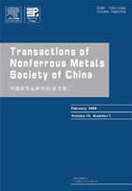Preparation of porous α-Ga2O3 nanowires by dealloying of Ga-based liquid metals to enhance cycling stability for lithium storage
(1. “The Belt and Road Initiative” Advanced Materials International Joint Research Center of Hebei Province, School of Materials Science and Engineering, Hebei University of Technology, Tianjin 300401, China;
2. School of Science, RMIT University, Melbourne VIC 3001, Australia;
3. State Key Laboratory of Advanced Processing and Recycling of Nonferrous Metals, Lanzhou University of Technology, Lanzhou 730050, China)
2. School of Science, RMIT University, Melbourne VIC 3001, Australia;
3. State Key Laboratory of Advanced Processing and Recycling of Nonferrous Metals, Lanzhou University of Technology, Lanzhou 730050, China)
Abstract: Ga2O3 is considered a potential anode material for next-generation lithium-ion batteries due to its high theoretical capacity and unique self-healing capability. To develop a novel preparation method and in-depth understanding of the electrochemical reaction mechanism of Ga2O3, a brand-new liquid-liquid dealloying strategy was exploited to construct porous α-Ga2O3 nanowire networks. Profiting from the well-designed porous structure, the material exhibits impressive cycling stability of a reversible capacity of 603.9 mA·h/g after 200 cycles at 1000 mA/g and a capacity retention of 125.2 mA·h/g after 100 cycles at 0.5C when assembling to Ga2O3//LiFePO4 full cells. The lithiation/delithiation reaction mechanism of the porous Ga2O3 anodes is further revealed by ex-situ Raman, XRD, TEM measurements, and density functional theoretical (DFT) calculations, which establishes a correlation between the electrochemical performance and the phase transition from α-Ga2O3 to β-Ga2O3 during cycling.
Key words: liquid metal dealloying; porous nanowires; Ga2O3; Li-ion battery; anode

